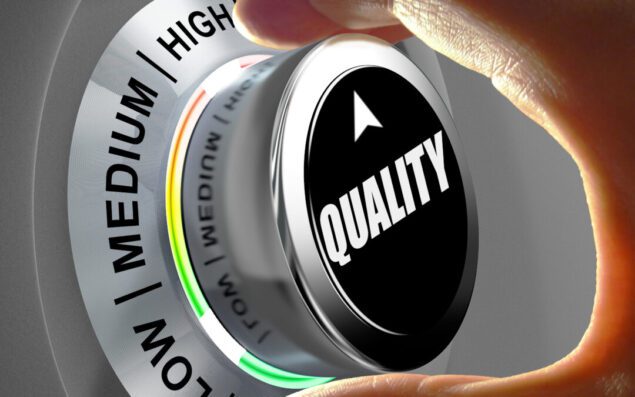We’re approaching the Federal Government’s spending rush that comes in the last two quarters of every fiscal year. In 2018, the Federal Government obligated roughly $560 billion to contractors. However, the Government obligated roughly $144 billion (26%) in Q3 and $186 billion (34%) in Q4 of 2018. This makes April through September an “enjoyable” time for BD and proposal professionals.
As more and more contracts flow through Indefinite Delivery Vehicles (GWACs, GSA Schedules, IDIQs, BPAs, etc.), we have to be on top of our proposal submission game. However, bad proposal habits are pervasive in the Government contractor community, and companies tend to recycle the same mistakes in their proposals.
Do your proposals reflect your company’s brilliance and the outstanding service you will provide the Government? Or, do your proposals leave the Government questioning whether your work on the contract will be ho-hum and feature errors, just like your bid?
Your proposals project the quality of work the Government can expect if they award the contract to your company. The quality of your technical proposal matters almost as much as your competitive advantage and pricing. Particularly as you move away from reverse auctions and the simplest form of the lowest price technically acceptable evaluation criteria on the Best Value Continuum.
You can improve your proposals and make them more competitive by increasing your evaluated score in the following six areas.
Proposal Organization
You’ve likely lost a bid as soon as a Government evaluator had to dig through your proposal to find the information required by the RFP that was buried or omitted. The section titles, numbering, and structure must track to the RFP requirements so it’s easy for an evaluator to find the information.
Within the sections, you should highlight evaluator-friendly keywords so the evaluator can skim across the pages and check the compliance box. Most importantly, proposals shouldn’t regurgitate the requirements. Instead, you should offer a definite approach that explains what you’re going to do, who is going to do it (by name or title), and how you’ll do it, using a step-by-step approach.
Effective Proposal Content
Your proposals present your solution through text, graphics, charts, tables, and other proposal elements. You must craft your solution to meet the Government’s problem in a way that feels custom for this customer. You should also strive to include a graphic that shows the 1,000 ft. view of how you will execute this contract.
If you can’t develop a concept of operations graphic, then likely you don’t have the technical expertise or customer knowledge to do the work and should consider no-bidding. Your proposals should consistently answer the “Ws” (what, who, how, when, and where) with the detail the Government needs to feel confident that you will do a great job on the contract.
Proposal Persuasiveness
Our proposals should start with the customer and be about the customer. You need to show an understanding of the customer’s hot buttons and tailor your solution to meet those needs. You should include at least three proposal-level win themes that contain features, benefits, and proof.
Most win themes we see are feature-feature win themes because they don’t explicitly explain how an element of your solution is better, faster, cheaper, or less risky.
You need to include qualified and quantified proof throughout your proposals, making use of customer testimonials, stories, and anecdotes to demonstrate your depth of knowledge and subject matter expertise.
Proposals should also employ written and visual metaphors to fill the evaluator’s senses and turn a complicated matter into something they can relate to.
Use of Proper Language and Voice
There is an elegance in simplicity. You should write your proposals at a high school reading level, even if you are discussing complicated technical subjects. Excessive adverbs, adjectives, and phrases like “we understand” and “unique” are like cologne/perfume—you can wear too much and destroy your credibility.
Minimize dense sentences, technical jargon, and phrases full of undefined acronyms that only your Subject Matter Experts know and don’t approximate quantities within your proposals.
Single-voice your proposals so they sound like the work of one author instead of an anthology. The Government doesn’t award points for verbosity and big words, so simplify and streamline before you submit.
Visual Appearance in Your Federal Proposal
An agency director once told us, “The contractor who won the most at [my agency] wasn’t necessarily the best contractor or had the best solutions; they submitted the prettiest proposals.”
The visual elements, body text styles, and fonts of your proposal should be consistent and make use of a modern palette. Some best practices for your proposal’s visual appearance include:
- Reduce the number of fonts to four or less and use nothing smaller than size 8 in your graphics (unless the Request for Proposal (RFP) tells you otherwise).
- Get rid of underlining and excessive use of capitalization—that is archaic.
- Place a visual on every page, which can be figures, focus boxes, tables, pictures, etc.
- Add titles and action captions to all graphics, written using a customer-focused feature-benefit structure.
- Ask a professional graphic artist to render your graphics and sharpen the intended concepts/takeaways.
An evaluator should be able to understand each graphic in under 10 seconds or less.
Edit and Proofread for an Accurate Proposal
Your proposals should be free of errors. However, when deadlines slip, the editing and polishing at the end of the process get shortened or cut outright. You will struggle to reconcile quantities, names, titles, sections, and cross-references. Evaluators get confused by these inaccuracies.
Additionally, every visual element should be within the margins and properly placed on the page. Your proposals should introduce exhibits in the text before the reader encounters them. Make sure there are no other major omissions and document imperfections that will make the evaluator think you’ll perform a sloppy job on the contract.
There are many things that contribute to a successful proposal but sharpening these 6 areas will significantly improve your proposals. We should all conduct post mortems or lessons learned after submitting a proposal to continuously improve. We should finalize the lessons learned after the Government’s debriefing.
However, the debriefs are often woefully short of any helpful information that would help us improve our proposals. Increase your win probability during the fiscal year-end spending rush with our solution to help you improve your proposals.
OST’s Proposal Assessment Brings You an Objective Evaluation from a Third Party That Has Seen Thousands of Proposals
Find out how good your proposals are and how competitive they make you in the Government market. Hear an expert’s perspective on how your proposals compare to the current industry best practices.
We will review one or two of your best technical proposals to measure them against the critical characteristics that contribute to a higher win_probability. We will review, score, and provide examples of what works and what doesn’t work, accompanied by recommendations for improvement in the six key areas.
We will document our findings in a written report and present it to you and your team in an interactive feedback session. It will cover strengths (what you’re doing right) and opportunities for improvement (areas where you could be more competitive). You will know exactly what to fix in your proposals, and how to go about it.
The Benefits of This Proposal Assessment (Review)
After our experts review your proposals, you and your team will:
- Gain an outside perspective to learn how your proposals compare to best practices learned and formulated by experts that have supported the top five Government contractors in competitive proposal development.
- Stop repeating mistakes that reduce your win_probability and cost you millions of dollars.
- Receive company-specific, targeted, non-generic recommendations on how to improve your win_probability through proposal quality.
- Increase your competitiveness in the current highly competitive environment.
- Validate what you do right, so you can amplify your success.
| “The proposal assessment was highly useful for us. OST gave us clear feedback about what we did well with our proposals and what we could improve. Normally with group proposal training, I feel overwhelmed with the sheer amount of things we should be doing that there is no way our small agency could actually do—at the end of meeting with OST for this assessment, by contrast, I felt confident that we could implement the input we received and bring our proposals up to the next level. Very appreciative—thank you for doing this.” -Eva Gillespie-Larsen, Senior Proposal Writer, New Dawn Technologies |
Your Investment in the Proposal Assessment (Review)
The review, report preparation, and debrief are $4,995for two proposals or $2,695for one. One proposal is enough to give you actionable recommendations, while two proposals would enable us to see patterns of how you do things, which adds another level of depth to the review.
Would you like to learn more about what comes with our proposal assessments? Click the button below to learn more and purchase your own assessment before the fiscal year-end rush.
If you have any additional questions, please contact us at [email protected] or (301) 384-3350.
Contact us to learn more.

